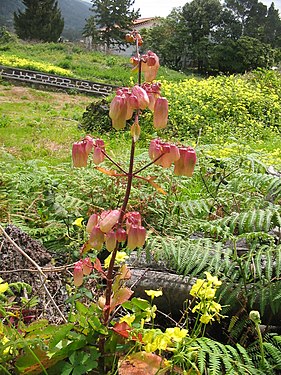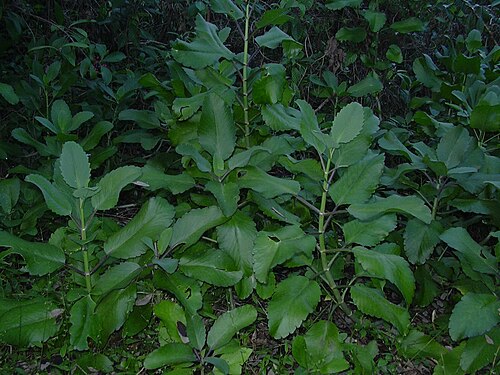Kalanchoe pinnata
| Habit | cacti-succulent
| |
|---|---|---|
| Lifespan: | ⌛ | perennial |
| Poisonous: | ☠ | can be toxic |
| Features: | ✓ | flowers, foliage |
|---|---|---|
| Flower features: | ❀ | red, green |
|
pinnata > |
If this plant info box on watering; zones; height; etc. is mostly empty you can click on the edit tab and fill in the blanks!
Kalanchoe pinnata (syn. Bryophyllum calycinum, Bryophyllum pinnatum, also known as the Air Plant, Life Plant, Miracle Leaf and Goethe Plant is a succulent plant native to Madagascar. It is distinctive for the profusion of miniature plantlets that form on the margins of its leaves, a trait it has in common with the other members of the Bryophyllum section of the Kalanchoe genus.
It is a popular houseplant and has become naturalized in temperate regions of Asia, the Pacific and Caribbean.
Read about Kalanchoe pinnata in the Standard Cyclopedia of Horticulture
|
|---|
|
Bryophyllum pinnatum, Kurz (B. calycinum, Salisb.). Figs. 673-4. Height 2-4 ft. : Lvs. opposite, fleshy, becoming leathery with age, earlier ones simple, ovate, with cordate or rounded base, later ones pinnate and then of 3-5 short- stalked lfts., the rachis and petiole with a narrow groove on the upper side, margin crenately doubly-serrate, light green becoming purplish along the veins toward maturity, margin purple as are also the petioles and young st.-growths: fls. pendulous, in terminal panicles; calyx much inflated, purplish green with lighter dots, 1½ in. long; corolla greenish white with purple-tinted, spreading acute tips. Tropics of both hemispheres. B.M. 1409. L.B.C. 9:877. G.C. 111.41:422. J.H.I1I.46:205. R.B. 24:125. R.H. 1900, p. 362. V. 3:117; 4:113; 7:340.—Said to be used in India as a diuretic.
|
Cultivation
Propagation
Pests and diseases
Varieties
Gallery
References
- Standard Cyclopedia of Horticulture, by L. H. Bailey, MacMillan Co., 1963
External links
- w:Kalanchoe pinnata. Some of the material on this page may be from Wikipedia, under the Creative Commons license.
- Kalanchoe pinnata QR Code (Size 50, 100, 200, 500)





